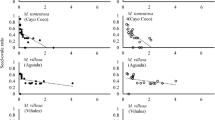Abstract
Pollen competition between species strongly influences hybridization dynamics in plants. By performing single- and mixed-donor pollinations, we show that soil Ca alters the outcome of interspecific pollen competition in the annual Phlox hybrid system of Phlox cuspidata and P. drummondii. In the absence of interspecific pollen competition, heterospecific pollen siring success of both species was influenced most strongly by the maternal growth environment, such that hybridization was facilitated when heterospecific pollen was deposited on stigmas of maternal plants growing in high Ca soils. When heterospecific pollen was forced to compete against conspecific pollen, however, the maternal growth environment did not influence hybridization, but the environmental origin of heterospecific pollen did, and this effect depended on the maternal species. Pollen of P. drummondii was more effective at outcompeting P. cuspidata pollen and preventing hybridization in P. drummondii dams when P. cuspidata pollen was derived from low Ca. Pollen competition within pistils of P. cuspidata was unaffected by pollen Ca environment. In situations in which P. cuspidata grows in lower soil Ca than P. drummondii, as has been documented in one population, these results suggest that the competitive ability of heterospecific pollen will be diminished by environmental effects of soil Ca. Thus, the environment in which pollen develops can influence interspecific pollen competition and hybridization frequency.


Similar content being viewed by others
References
Bradshaw HD Jr, Schemske DW (2003) Allele substitution at a flower colour locus produces a pollinator shift in monkeyflowers. Nature 426:176–178
Brewbaker JL, Kwack BH (1963) The essential role of calcium ion in pollen germination and pollen tube growth. Am J Bot 50:859–865
Chichiriccò G, Ragnelli AM, Aimola P (2002) Ovary-ovule transmitting tract in Crocus (Iridaceae), structure and calcium distribution. Plant Syst Evol 235:155–167
Coyne JA, Orr HA (2004) Speciation. Sinauer Associates, Inc., Sunderland
Cruzan MB, Barrett SCH (1993) Contribution of cryptic incompatibility to the mating system of Eichhornia paniculata (Pontederiaceae). Evolution 47:925–934
Erbe L, Turner BL (1962) A biosystematic study of the Phlox cuspidata-Phlox drummondii complex. Am Midl Nat 67:257–281
Ferguson CJ, Levin DA, Jansen RK (1999) Natural hybridization between an outcrossing and a selfing Phlox (Polemoniaceae): the maternal species of F1 hybrids. Plant Syst Evol 218:153–158
Grant V, Grant KA (1965) Flower pollination in the Phlox family. Columbia University Press, New York
Hoagland DR, Arnon DI (1938) The water-culture method for growing plants without soil. Circular 347. University of California, College of Agriculture, Berkeley
Holdaway-Clarke TL, Hepler PK (2003) Tansley review: Control of pollen tube growth: role of ion gradients and fluxes. New Phytol 159:539–563
Levin DA (1967) Hybridization between annual species of Phlox: population structure. Evolution 29:37–51
Levin DA (1970) The exploitation of pollinators by species and hybrids of Phlox. Evolution 24:367–377
Levin DA (1975) Interspecific hybridization, heterozygosity and gene exchange in Phlox. Evolution 29:37–51
Levin DA (1978) Genetic variation in annual Phlox: self-compatible versus self incompatible species. Evolution 32:245–263
Levin DA (1981) Dispersal versus gene flow in plants. Ann Mo Bot Gard 68:233–253
Levin DA (1985) Reproductive character displacement in Phlox. Evolution 39:1275–1281
Levin DA (1989a) Inbreeding depression in partially self-fertilizing Phlox. Evolution 43:1417–1423
Levin DA (1989b) Proximity-dependent cross-compatibility in Phlox. Evolution 43:1114–1116
Levin DA, Kerster HW (1968) Local gene dispersal in Phlox. Evolution 22:130–139
Levin DA, Kerster HW (1974) Gene flow in seed plants. Evol Biol 7:139–220
Levin DA, Schaal BA (1970) Corolla color as an inhibitor of interspecific hybridization in Phlox. Am Nat 104:273–283
Marshall DL, Diggle PK (2001) Mechanisms of differential pollen donor performance in wild radish, Raphanus sativus (Brassicaceae). Am J Bot 88:242–257
Mascarenhas JP, Machlis L (1962) Chemotropic response of Antirrhinum majus pollen to calcium. Nature 196:292–293
Mascarenhas JP, Machlis L (1964) Chemotropic response of the pollen of Antirrhinum majus to calcium. Plant Physiol 39:70–77
Montalvo AM (1992) Relative success of self and outcross pollen comparing mixed- and single-donor pollinations in Aquilegia caerulea. Evolution 46:1181–1198
Nixon ES (1964) Edaphic responses of Lupinus texensis and Lupinus subcarnosus. Ecology 45:459–469
Quesada M, Bollman K, Stephenson AG (1995) Leaf damage decreases pollen production and hinders pollen performance in Cucurbita texana. Ecology 76:437–443
Ramsey J, Bradshaw HD Jr, Schemske DW (2003) Components of reproductive isolation between the monkeyflowers Mimulus lewisii and M. cardinalis (Phrymaceae). Evolution 57:1520–1534
Rieseberg LH, Carney SE (1998) Tansley Review No. 102: Plant hybridization. New Phytol 140:599–624
Ruane LG, Donohue K (2007) Environmental effects on pollen–pistil compatibility between Phlox cuspidata and P. drummondii (Polemoniaceae): implications for hybridization dynamics. Am J Bot 94:219–227
Travers SE (1999) Pollen performance of plants in recently burned and unburned environments. Ecology 80:2427–2434
Young HJ, Stanton ML (1990) Influence of environmental quality on pollen competitive ability in wild radish. Science 248:1631–1632
Acknowledgements
We are grateful to J. and B. Allbright, J. and P. Burns, D. and C. Griffen, R. and G. Holder, D. Levin, D. Ruane, R. Stomberg, and everyone in Wequaquet Heights. Funding was provided by an NSF Graduate Student Fellowship to L.R. and by the Department of Organismic and Evolutionary Biology at Harvard University.
Author information
Authors and Affiliations
Corresponding author
Rights and permissions
About this article
Cite this article
Ruane, L.G., Donohue, K. Pollen competition and environmental effects on hybridization dynamics between Phlox drummondii and Phlox cuspidata . Evol Ecol 22, 229–241 (2008). https://doi.org/10.1007/s10682-007-9174-8
Received:
Accepted:
Published:
Issue Date:
DOI: https://doi.org/10.1007/s10682-007-9174-8




